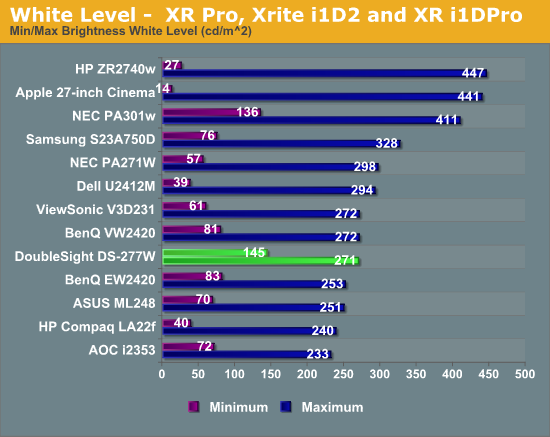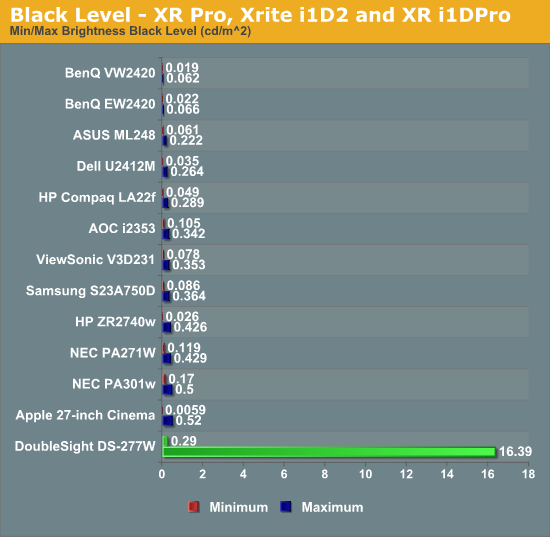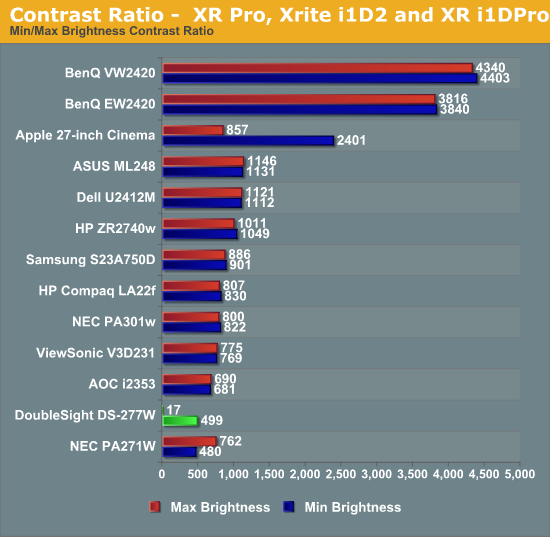DoubleSight DS-277W: Back to the Drawing Board
by Chris Heinonen on June 13, 2012 1:30 AM ESTMost of the 27” monitors that have come through have been able to get incredibly bright, as the backlighting systems need to be pretty powerful to light up a 27” panel well and keep uniformity. Here the DoubleSight comes in closer to the NEC PA271W than to the other 27” or 30” monitors we have tested and can only put out 271 nits at maximum brightness. With the brightness set to minimum we only get down to 145 nits, which is much brighter than anything else we have tested, and it means that our 100 nits dE testing required lowering the output level by adjusting the LUTs in the video card, which can cause posterization and other issues.

The black level at the minimum backlight is 0.29 nits, which is pretty reasonable. I also engaged the dynamic backlighting system and that dropped the level on a black screen down to 0.189 nits, which improves the contrast ratio quite a bit. Unfortunately, you can clearly see the dynamic backlight in use, and the screen fluctuates in brightness very clearly, which I found to be very annoying in use. The main issue is looking at the black level at maximum brightness, as it is over 16 nits! That’s over 32 times as bright as the closest display and really out of the ordinary, so what is going on?

The answer lies in how TV and Monitor controls work. On a TV, brightness controls the level of black, and contrast controls the level of white, and on a flat panel TV there is typically a backlight or cell light control to adjust the light output. On a monitor, there is no backlight or cell light control; brightness handles that. Since computer displays use the full 0-255 RGB gamut, unlike video that uses 16-235, there is no need for a black level adjustment. On the DoubleSight, the electronics are designed to work like on a TV, so instead of adjusting the light output, we are adjusting the black level. Similarly Contrast serves the purpose now of controlling white and the maximum light output. Basically, for use as a computer display, these controls are not designed correctly.
Given that black level, we would expect to see the contrast ratio at maximum light output be pretty poor, and it clocks in at 13:1. At minimum it was a respectable 499:1 and even at 200 nits I measured around 400:1, but once the brightness gets too high, your contrast ratio goes away.

Suffice it to say, the DS-277W was not a good performer on the brightness and contrast testing here. Hopefully that doesn’t carry over to every aspect of the display.










55 Comments
View All Comments
esSJae - Thursday, June 14, 2012 - link
3 monitors? I use DP for my main monitor on my AMD 6970, DVI for the other 2.6 monitors? Better have DP.
dertechie - Monday, June 18, 2012 - link
Anyone using Eyefinity is using either DP or an expensive DP to X converter. Given what those cost, a lot of us just use DP if we picked up the 3rd monitor in the last 3-4 years.DP has a lot more support than just Apple. It's cheaper on the transmitter side than DVI or HDMI (and probably VGA by now), so such insignificant players as AMD, NVidia and Intel are dropping legacy connectors as quickly as they can get away with it. Much less penetration on the monitor side of things though.
cheinonen - Wednesday, June 13, 2012 - link
Well, the specs said it had DisplayPort, but really we were trying to do a round up of as many 27", 2560x1440 models as possible. There aren't too many of them out there but this was one of them.Mitch89 - Saturday, June 16, 2012 - link
I'm also a little confused about this sentence:"... the DS-277W is to make a monitor that can work with all of your devices, not just your computer. It has multiple AV inputs (HDMI, Component) for your Blu-ray player or video game systems, and there are integrated speakers for audio from these devices as well. "
The Dell U2711 has DisplayPort, 2x DVI, VGA, HDMI, Component and even composite connections, and has been out for quite some time (updating previous 27" Dells that had similar connectivity).
It would seem if multimedia and all-round connectivity is the priority, then the Dell has this thing beat.
That's without considering Dell's excellent exchange warranty.
cheinonen - Saturday, June 16, 2012 - link
In the conclusion I mention the Dell U2711 and that if you need that connectivity, you should buy the Dell instead. I see no reason to pick the DS-277W over the Dell, or really any other 27", and mention that in the conclusion.damianrobertjones - Wednesday, June 13, 2012 - link
All these screens really need to start featuring touchVoo - Saturday, June 16, 2012 - link
Yep stretching your whole body so that you get into touch range of your 30" monitor (you hardly sit 20cm away from one do you?) and then having to deal with all those fingerprints and smears sounds PERFECT! Can't wait for this totally useless feature that will probably double the price of monitors.Jedi2155 - Wednesday, June 13, 2012 - link
I'm not sure if you're familiar with the Yamasaki Catleap, which is a potentially 120 Hz capable 27" IPS display, but I've been really wanting to get one once the people organizing it, can get some more built. I would love an Anandtech review on it as well. I already plan on getting one as soon as they are available, so I don't need you guys to tell me to get one, but it would be good to get more manufacturers on the 120 Hz PC bandwagon that isn't a 3D TN based display....http://120hz.net/content.php
anishannayya - Wednesday, June 13, 2012 - link
Correct me if I'm wrong here, but don't you really need to push 120+ FPS to discern the benefits of 120hz? How could you do this when you are already trying to drive the display at 1440p? Furthermore, once you SLI cards, don't you restrict the maximum hz a display can be set at?Sure, you could do it when you aren't gaming, but what is the point of that? Making your cursor move more "smoothly"? Does it even matter unless you are gaming?
MamiyaOtaru - Wednesday, June 13, 2012 - link
Not every game is Crysis. There are plenty of games that a modern card can render at 120+ fps